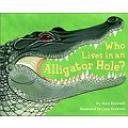"What do you know about alligators?" After reading the nonfiction picture book, Who Lives in an Alligator Hole? written by Anne Rockwell and illustrated by Lizzy Rockwell, readers will have learned facts about alligators, their history, wetland habitat, and their impact on the unique ecosystem they inhabit. During the dry season in Florida’s wetlands, alligators create gator holes by digging in damp muck and thrashing about to shove the thick muck away. “Soon a wide hole fills with water a few feet deep. Then a lot starts to happen in the gator hole,” as numerous species of animals are drawn to the watering hole. The author explains that scientists consider alligators to be a “keystone species” because of their importance to the other plants and animals in their habitat. Next the author traces the dramatic impact that humans have had on the American Alligator who came close to extinction thirty years ago and what has been done to save them. Today, “[t]he American alligator is one of the world’s most successful stories of a species saved from extinction just in time”. Readers are asked to think of ways to save the Chinese alligator who continues to be endangered. The illustrations are simple and work well to support the text. The book ends with an activity designed to help students understand why other animals are dependent on the alligator hole for water and a page of “Gator Facts” that don’t fit elsewhere in the story. This book is yet another successful introduction to basic science concepts from the Let’s-Read-and-Find-Out About Science Series.
Curriculum Connections
Like most of the books in the Let’s-Read-and-Find-Out About Science series, this book addresses several themes from the standard elementary science curriculum. The book is best used to teach living systems and the interdependence of living organisms with their living and nonliving surroundings and the ways that habitats change over time (2.5, 3.5, and 4.5), particularly in water-related environments (3.6, 3.9, and 6.7d). But the book can also be used to teach about the impact that natural events and human influences can have on a species or habitat (K.9a, 3.10a-b, and 6.9d).
- American Alligator – National Geographic Kids– This site includes a number of facts and supporting information about the American Alligator and its habitat, video footage of the reptile in his natural setting, and a map of the areas where he lives.
- Endangered Species Program – Kids Can Help – This site for kids from the U.S. Fish and Wildlife Service includes a number of ideas for kids to help conserve rare, threatened and endangered species and their habitats.
- Lesson Plan on Endangered Species – This lesson plan is a good extension activity to use when talking about the impact of human intervention on ecosystems and endangered species. It could even be adapted to the Chinese Alligator mentioned in the book.
- Mini-Ecosystems Lesson Plan – This lesson plan is written with a third grade classroom in mind. Students make small-scale environments and describe the interactions between living and nonliving things in their environments.
Book: Who Lives in an Alligator Hole?
Author: Anne Rockwell
Illustrator: Lizzy Rockwell
Publisher: Collins
Publication Date: 2006
Pages: 40
Grade Range: PreK-3
ISBN: 006445200X

